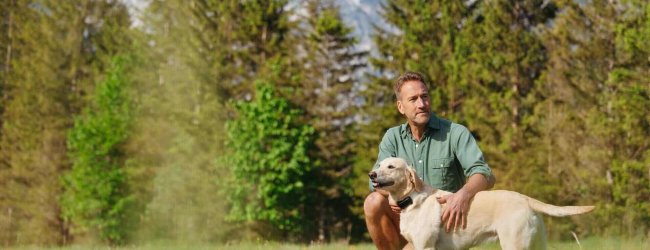How To Train A Deaf Dog & Help Them Live Their Best Life
Got a senior dog at home - or one that's been born hard of hearing? Wondering how to train a deaf dog by yourself? Here's how to get started - and set them up for a lifetime of success.
Whether it’s because they’re getting a bit whiter around the whiskers or it’s something they’ve been born with – living with a deaf dog can be an adventure of its own. But the first thing to keep in mind: your buddy might not be able to respond to your voice like others. Which might make you might be wondering: how to train a deaf dog? Especially to come back when called if we’re both outdoors together…and they want to explore?
With patience, consistency, and a little emergency planning for your outdoor adventures, you can train your buddy to understand and respond to your cues – and live a long, happy, fulfilling life by your side. Here’s how.

Always know your buddy is healthy & safe
Read moreHow to train a deaf dog 101: Getting started
It might seem unlikely, but training a deaf dog isn’t too different from training any other dog – regardless of their hearing! Rather, they rely on their other senses, including their vision, smell, and touch to figure out what you’re expecting of them.
Just make sure that everyone in your household is consistent as well – using the same cues or hand signals as you. (You could even hang up a poster to help everyone remember.) This can help create a stable, consistent environment at home for your dog and get them learning and responding even quicker and better.
First, get your dog’s attention – without startling them
Deaf dogs can be easily startled – since they can’t hear your or others approaching. That’s why experts actually recommend you help your dog get used to being touched unexpectedly.1 When your voice isn’t an option, touching them gently on the side or shoulder can help attract your dog’s attention when you need them to do something. And once you teach them to pay attention to you, you can move to other basic dog commands.
If you want to attract your dog’s attention, you could also:
- Walk into their line of sight.
- Very lightly stomp your feet – so that they feel the vibrations on the floor. (But not too hard, else you might frighten them.)
- Use a flashlight – or turn the lights of the room on and off.
- Very gently touch your dog somewhere on their shoulder – when they’re relaxed, but facing away from you. Avoid touching their head or somewhere “sensitive.”
- When your dog turns around, give them a big smile and a treat. (Yes, your dog can tell how you’re feeling from your expressions and mannerisms, even if they can’t hear your voice.)
- Rinse, repeat, and practice – these steps will help your dog begin to associate an unexpected touch with a reward. So they’ll be less likely to startle.
How to train a deaf dog to “Watch” you
Once you’ve picked up how to get your deaf dog’s attention, it’s important to teach them how to maintain it – especially if you’re both in an environment with a few distractions. Which is where it helps to teach them the “Watch me” command, to keep their attention. Like so:
- Hold a treat or a chew toy in your hands within your dog’s line of sight – your buddy will follow it with their eyes naturally.
- The minute your dog stops looking at the treat and at you instead, give them a thumbs up signal. (Communicating, “Good!”)
- Hand them the treat after.
- Gradually increase the length of time your buddy keeps looking at you before you give them the treat.
- If your dog breaks eye contact, repeat these steps – and practice plenty.
Next, teach your dog these basic commands
With consistent hand signals, you can attract your dog’s attention and teach them that a specific hand signal = a command. (And when they comply, that means a treat!) Make sure to use some exaggerated movement at first – so your buddy gets used to them. (And then gradually reduce them over time.) Besides, we’d also recommend you:
- Smile a ton and speak any praise out loud. Yes, it might seem counterintuitive to verbally praise a deaf dog, but it can help keep your body language positive. All of which can help positively reinforce any training commands.
- Always make sure your dog’s attention is on you first, so they’re less distracted.
- Keep your training sessions short – 5-10 minutes, tops.
- Focus on one command at a time to avoid confusing your dog.
- Practice the same command several times before moving on to any other. Deaf dogs will need even more repetitions than hearing dogs, as well as even more consistent reinforcement.
With these points in mind, here’s how to train a deaf dog to…
“Sit“
Just like with hearing dogs, hold a treat above your dog’s nose and move it upwards. Your buddy will follow it with their nose – and end up “sitting” entirely by themselves.
- When they do, use a hand signal (e.g., your palm facing downward and moving in a “down” motion) to indicate “Sit.”
- Repeat this hand signal a few times to help your dog learn the connection between the hand signal and the behavior of sitting.
- When your dog does sit, give them a thumbs up – and a treat just a few seconds after.
- Repeat these steps until your dog learns that “palm moving downwards = Sit.” With time, you can give them fewer and fewer treats until they learn to respond to the hand signal by themselves.
“Stay“
- Get your dog’s attention with a treat and a thumbs up once they’re in a “sitting” position.
- Use a hand signal like your open palm facing your dog – and then take a step back.
- If your dog remains in place, give them a thumbs up and a treat.
- If your dog follows you, get them to “Sit” again – and repeat the steps.
- Gradually increase the distance and how long your dog should hold the “Stay” position.
“Quiet”
A common problem you might run into with deaf dogs is them barking a bit more or louder than other dogs. In this case, a hand signal indicating a “Shh!” motion (or a finger on your lips) can come in handy. Along with some toys or treats as distraction. Now if, for example, you’ve got a dog barking out of frustration or boredom:
- Get their attention with a toy or a treat in their line of vision.
- Use the “Shh!” hand signal as you place the treat at your dog’s feet to distract them.
- As your dog bends over to eat the treat or play with the toy, they might stop barking.
- Give them a thumb up and a ton of pats once they’re quiet.
- If your dog keeps barking, repeat the steps – and make sure they see you giving them a thumbs up when they do stop.
“No“
For a deaf dog, it might be better to teach them a general hand signal communicating “No!” instead of a verbal command. This could be holding out an index finger and shaking it left to right. Always pair the hand signal with removing the object (like food) or putting them for a few minutes in their crate or not letting them continue their activity. With time, this will help them learn that certain behaviors = “No!” = not being able to do something.
Now these basic commands work great for helping your dog manage the indoors. Using a thumbs up and a treat can also come in handy for:
- Potty training them, or when you reward them for relieving themselves in the correct spot
- Cleaning up after themselves or putting away their toys after playtime
- Getting along with other pets and people – without getting too rough or noisy
So now it’s time to figure out…
How to train a deaf dog to survive the outdoors
In general, experts recommend keeping your dog close by when you’re outdoors – especially if they have difficulties hearing you.
“Never allow a deaf dog to be off-leash in an unfenced, open area. It is too easy for a deaf dog to get spooked or distracted and run into harm’s way.
Deaf dogs can wear a long line or drag line to have more freedom to explore while still saying safely within your view.”
– VCA Animal Hospitals2
So with that in mind, we’d recommend you:
Socialize your dog plenty
Even with their special needs, spending time in different environments helps your dog learn how to control their impulses and behave – helping them adjust better and reduce anxiety in new situations. So with your buddy firmly leashed to your side, make sure to take them to:
- Dog parks and other community areas around you, where they can interact with other dogs and dog parents.
- Your wider neighborhood, where it’s always a good idea to become a familiar face among your neighbors – who can alert you if they see your buddy wandering around the neighborhood.
- The vet’s clinic, where you should ideally be taking your dog regularly for checkups.
- Dog-friendly cafes and restaurants, where they need to learn not to lunge at every plate they see!
- Public transport, where – besides a leash – your buddy might also need to be muzzled the entire time.
💡Start slow and introduce your buddy to these new environments, bit by bit. Each one of these is a potential training opportunity for basic commands like “Sit,” “Stay,” and “Quiet”. So your dog learns to adjust and behave accordingly. (Especially in an environment full of distractions!)
Get your buddy used to some gentle handling
Eventually, your dog is going to have to deal with “strangers” handling them. (Like veterinary staff or even your local dog grooming service). And they’ll have to do so without barking, biting, or even peeing themselves in fright.
So it’s wise to start with a simple, gentle grooming routine at home – brushing out your dog’s coat on the regular, for starters. Gradually introduce your dog to grooming tools like nail clippers – and put them away immediately if your buddy spooks at the sight of them. Keep some treats around and make sure to reward your dog plenty when they do behave.
💡Stick around while your dog gets groomed or brushed by someone else (ideally someone they’re familiar with, at first). With time, they’ll learn that these experiences are neutral and non-threatening – even positive – and it won’t spook them as much when a “stranger” does them instead.
Train your dog to come back when called
We’ve covered the basic commands above – now it’s time to get more serious. Having a good recall (or coming back when called) can potentially save your dog’s life if they’ve run away from you outdoors. But how to train a deaf dog to come back when…well, they can’t hear you actually call out for them?
In these situations, you’ll have to be more vigilant than ever. Keep a firm hand on your buddy’s leash to prevent an escape. But if they do:
- Get in their line of vision and wave to get their attention.
- Open out your arms and make yourself look as happy as possible to encourage your dog to come back to you.
- Otherwise, a hand signal like your open hand moving towards your chest can substitute for the “Come back,” command.
- Make sure to practice in a safe, enclosed area where your dog isn’t likely to get distracted. (But gradually move towards an area that does have some distractions, for some better practice.)
⚠️Just be warned: if you’re training a deaf puppy or a younger, high-energy dog, an environment full of distractions means at least a few thousand reasons they might end up running away to explore or investigate.
In these cases, a dog GPS tracker can be a potential lifesaver.

Follow your dog anywhere
Get real-time location information, wherever they go. And find out when they try to make an escape, or just when they go somewhere they shouldn’t, with Virtual Fences.
Ready to set your buddy for a long, happy, safe life by your side?
You wouldn’t be the first dog parent to wonder how to train a deaf dog to sit, stay, and come back when called – especially when their safety’s concerned. But with patience, consistency, and a ton of treats, you can learn to find it a highly rewarding, fulfilling experience and learn to enjoy your journey of learning and growing together.
And if you’ve liked this post, share it with a friend or a loved one – and let’s help build a safer, kinder world for our furry friends together.



